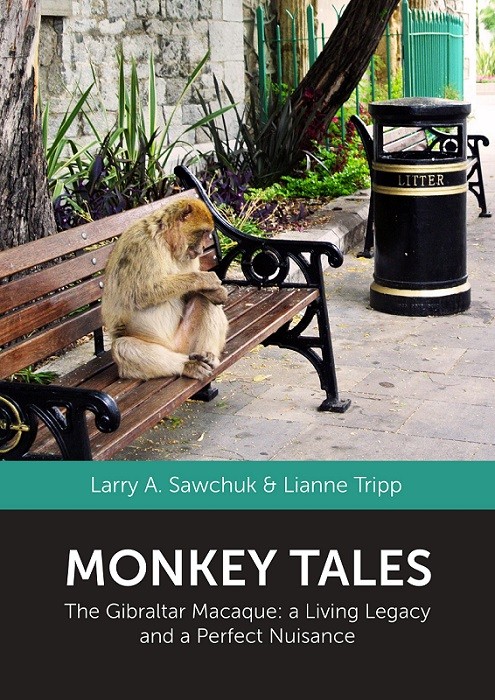'MONKEY TALES' - New Book Published by The Gibraltar National Museum

Joining this year's Gibraltar International Literary Festival were Prof. Larry Sawchuk and Dr. Lianne Tripp to launch their new book Monkey Tales published by the Gibraltar National Museum.
New book
On one hand, the Gibraltar macaque is viewed as iconic: a living legacy and symbolism of Britishness. On the other hand, the monkey is considered as a pest, a nuisance, and at times, a menace. The ongoing tension that exists for over three centuries sets the backdrop for showcasing the Gibraltar macaque on the global stage.
As every visitor to Gibraltar knows meeting the monkeys face-to-face is among the things to see while on the Rock. Monkey Tales will add to that experience by taking you on a journey through time from their early appearance in Gibraltar, during Moorish times to today. You will learn the answers to both fact and fiction about the only “wild monkeys in Europe”. Is there a monkey cemetery located in Gibraltar? Is it true that every Governor of Gibraltar has issued at least one edit about the monkeys? Why was Tony the Ape Dictator Executed in 1944? Is there a tunnel from Gibraltar to North Africa, and is that where the monkeys bury their dead? What do the ravens and the Tower of London, and Gibraltar apes have in common? Is it true that the monkeys can speak? When, and why, did the monkeys have names and serial numbers in the British Army? Why did Churchill order more monkeys to be imported from North Africa during the Second World War? What is the Monkey Book, and who wrote it? Are the monkeys actually the Lions of Gibraltar? Are the Gibraltar macaques the earliest example of primate conservation in the World?
The authors
Prof. Sawchuk is a biological anthropologist at the University of Toronto Scarborough, Canada. In 2013, he won the prestigious University of Toronto President Teaching award. He is no newcomer to Gibraltar, having spent 40 years carrying out his research here. His major focus is on the medical and demographic history of Gibraltar. Larry has written a number of articles and a book that reflects a wide interest of topics that deal with such subjects as: marriage patterns, patio life, epidemics, and much earlier in his, career the Gibraltar macaques. The work covers the period from British occupation in 1704 to the current post-border closure period. His research continues today, by looking outward at Malta to gain a greater sense of perspective on the shared and different experiences of these populations over the past three centuries. The approach taken in the majority of his studies falls within the anthropological perspective. His research methods also embrace holism, the case study approach, and importantly, the recognition that the Gibraltarian ethos is not a static quality, but one that is in flux and changes in response to the external socio-political climate. Another of his long-standing interests includes the use of innovation methods such as electronic and computer games for teaching. Photography of people and the urban landscape are other interests of his. Larry’s travels have taken him across much of North America, and Canada. London, Gibraltar, and Gozo are among his favourite places.
Dr. Lianne Tripp completed her PhD. in Biological Anthropology under the supervision of Prof. Sawchuk at the University of Toronto in 2017. Since graduating, she has been an assistant professor in the Department of Anthropology at the University of Northern British Columbia, Canada. As a biomedical anthropologist, her primary research area focuses on the demography (population studies), and the health of the 19th and 20th century small-scale and largely marginalised populations of Gibraltar and the Maltese islands (Malta and Gozo). Her research uses both qualitative and quantitative approaches to revealing disease and health disparities across the difference communities in Gibraltar- such as by religion, economic status, age and sex- and between the colonial nations of Malta and Gibraltar. Lianne’s research has examined the disease experience of cholera, 1918 influenza, tuberculosis, and undulant fever. This is Lianne’s first book, after having published numerous academic papers. Having acquired knowledge on the various communities of Gibraltar, and having a general interest in the history of the people and place, Lianne became fascinated with understanding the history of the macaques, especially in their interaction and dependency on humans, primarily the British military, for their survival on the Rock. Lianne especially enjoyed the challenge of tracing the origins of the Gib macaques, and she looks forward to continuing to uncover more on the monkeys’ history. Lianne is an avid gardener and baker. She enjoys the great outdoors and hiking in Canada’s vast wilderness.
Published: October 15, 2019
Other similar News
News
The #IceAgeEuropenow touring photographic exhibition arrives in Gibraltar
Published: March 16, 2019
18-20 Bomb House Lane
PO Box 939,
Gibraltar
